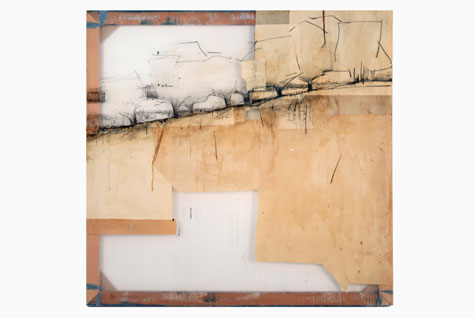
LOCAL ESSENCE ‘Eastern Prom,’ by Tom Hall, mixed media on plastic sheeting, 48 by 48 inches, 2002. |
Throughout 2011, June Fitzpatrick has done more than her share in highlighting the medium of drawing in the context of the state-wide project "Where to Draw the Line." Her current Congress Street show marks the eleventh iteration to focus on a medium she considers "the beginning of everything." However, many of the works on view are anything but mere beginnings.
My favorite works happen to be the smallest and least substantial. Using just a few pictorial elements, Kimberly Convery's small line drawings describe a mass exodus via airborne balloons in a historical and geographical limbo. Sadly, some aren't making it in this narrative of human endeavor and striving that is imagined with whimsy and superb compositional economy.
Right up there with Convery in rarefied elegance are Jeff Woodbury's "Marigold" ink drawings. Leaving maps behind, Woodbury retains his interest in hierarchical branching in these intricate renderings inspired by the plant's root system. In Woodbury's lyrical branch silhouettes layering of information is foregrounded, but of an organic, not man-made, nature. While these drawings stem from a complex line of inquiry, the artist's abstract bleach drawings appear too concerned with material experimentation and lacking a satisfying concept.
In Richard Wilson's graphite drawings sexual fantasies clash with socially acceptable behavior; they are raucous visions of a decidedly male imagination expressed in a refreshing figurative mode. In Alison Hildreth's work the paper alone is soaked with history into which the artist embedded her personal narrative of symbols and directional flow. Hildreth invites and richly rewards our contemplation of these subtly layered artifacts retrieved from a place of experience. Dudley Zopp contributed some unremarkable oil pastels as well as three delightful sumi ink drawings that exalt a single calligraphic flourish into creating volume and weight.
Through subtle use of color and variations of graphite value, Noriko Sakanishi's series "Ups & Downs" suggest movement, a sequential reading of gridded columns that runs counter to tradition. However, in the aptly titled "Find a Way," dynamics and hierarchies are not as easy to establish and the maze of directional emphasis and weight within parallel constructions of line is enigmatic and highly intriguing.
Joanne Mattera's vibrantly colored gouaches are extremely simple — vertical transparent brushstrokes of pink interacting with multi-hued horizontal ones. This predictability, however, contrasts with the accumulation of small incidents that happen along the way, the way a stroke feathers out, the slight divergence of two layered strokes, the drips of a heavily laden brush. Together with a pulsating on-or-off chromatic effect, Mattera's works offer a colorful feast for the eyes.
Tom Hall's pieces of varying scale date as far back as 1998. The composition of his large painting "Sebago 2" is loosely held together by a few charcoal lines intimating a landscape. It feels as evanescent as an exhalation. The notion of breathing material and imagery onto its support rings true for most of Hall's work in this show. Sheet music and Kraft paper are not only the basis for drawings but also act as constitutive elements of compositions. Plastic as support left visible calls into question material solidity, as seen in "Eastern Prom." It's as if Hall had assimilated the land on frequent visits and with a few light or vigorous touches, recreated its essence.